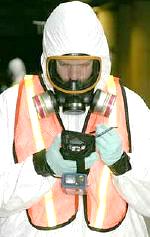 美國政府機構投資開發一項新工具軟體,可快速復原遭污染之建築物。此套系統包含PDA應用軟體,協助使用者建立精確污染區圖像以及進行區域抽樣,目前正開放外界申請軟體授權。
美國政府機構投資開發一項新工具軟體,可快速復原遭污染之建築物。此套系統包含PDA應用軟體,協助使用者建立精確污染區圖像以及進行區域抽樣,目前正開放外界申請軟體授權。
這套名為「建築復原操作最佳化模型」(BROOM)的軟體系統,最初是開發用來清理生物恐怖主義攻擊事件的;但開發者指出,它對於諸如機場、地鐵、出入境港埠、政府大廈以及工業區等重點區域的環境清查也是有所助益的。
BROOM系統由國土安全部門提供資金並由桑迪亞(Sandia)國家實驗室研發,用以處理環境採樣資料的彙集、形象化以及分析。領導BROOM系統朝向商品化的桑迪亞工程師兼事業發展合夥人蘭普(Jane Ann Lamph)指出:「現階段由環境遭受污染地區收集樣本的確是煞費苦心的,緊急應變卡(hazmat)的反應過程也太過費時」。
BROOM的重點裝備是一手持設備,看起來就像是裝載了大量資料和資訊的典型PDA。該設備使用精密演算法來產生污染地圖以及收集樣本反應器的佈局位置,並以此發展基本統計取樣計劃。
在時間緊急的事件中,需要大量迅速的抽樣資料,這些資訊可用安全的無線傳輸方式傳送給位於污染外圍區域的個人電腦或中央指揮部。結果可同時顯示在手持設備及遠端電腦的地圖上,允許決策者確定該區域是否真正安全無虞,並且儘快地重新開放該區域。
蘭普指出,關閉公共場所或企業的花費將是極其昂貴的,因此藉由BROOM系統所節省的費用將可高達上百萬美元。蘭普援引美國《商業週刊》(Business Week)數據指出,在911攻擊事件之後關閉華盛頓特區雷根(Ronald Reagan)國際機場23天的費用,據估計每天造成機場和北維吉尼亞企業約3億3千萬的損失,州政府及地方稅收短少2,700萬。
BROOM系統可改善清理行動的效率,使場所關閉的期間縮至最短,並提供透明化決策的依據。蘭普認為在宣稱一個場所是「安全無虞的」並重新開放之前,爭取公信及合法性是很重要的。
 A new software tool that allows for rapid reoccupation of contaminated buildings has been developed and funded by U.S. government agencies and is now available for licensing. The system includes a personal digital assistant (PDA) application that allows users to generate precise maps of contamination and sampling locations.
A new software tool that allows for rapid reoccupation of contaminated buildings has been developed and funded by U.S. government agencies and is now available for licensing. The system includes a personal digital assistant (PDA) application that allows users to generate precise maps of contamination and sampling locations.
Called the Building Restoration Operations Optimization Model (BROOM), the software system was originally developed for use during cleanup following a bioterrorism attack, but developers say it will also be useful for environmental cleanup of Superfund sites, airports, subways, ports of entry, government buildings and industrial facilities.
Created by Sandia National Laboratories for managing the collection, visualization, and analysis of environmental sampling data, development of the software was funded by the Department of Homeland Security. "Collecting samples from a contaminated facility is currently a painstaking, time consuming process for hazmat responders," says Jane Ann Lamph, a Sandia engineer and business development associate leading the BROOM commercialization effort.
The centerpiece of BROOM is the handheld device, which looks like a typical PDA but packs a large amount of data and information. The device uses sophisticated algorithms to generate contamination maps and layouts of the location where the responders are collecting samples and to develop statistically based sampling plans.
During time-sensitive events when sampling data is needed quickly, information can be wirelessly transmitted to a personal computer or central command station outside the contaminated area in a secure manner.
The results can be displayed on a map on both the handheld device and the remote computer, allowing decision makers to determine if an area is truly clean, and to reopen facilities as quickly as possible.
The cost to shut down public facilities, plants, or businesses can be enormous, so the savings obtained by using the BROOM could amount to many millions of dollars, Lamph says. Costs of the 23 day closure of Ronald Reagan National Airport in Washington, DC after the 9/11 attacks have been estimated at $330 million per day to the airport and Northern Virginia businesses, and $27 million to state and local tax revenues, Lamph says, citing "Business Week" figures.
BROOM improves the efficiency of cleanup operations, minimizes facility downtime, and provides a transparent basis for reopening. Lamph says transparency is critical in gaining public and regulatory acceptance for declaring a facility to be "clean" and safe to reoccupy.






